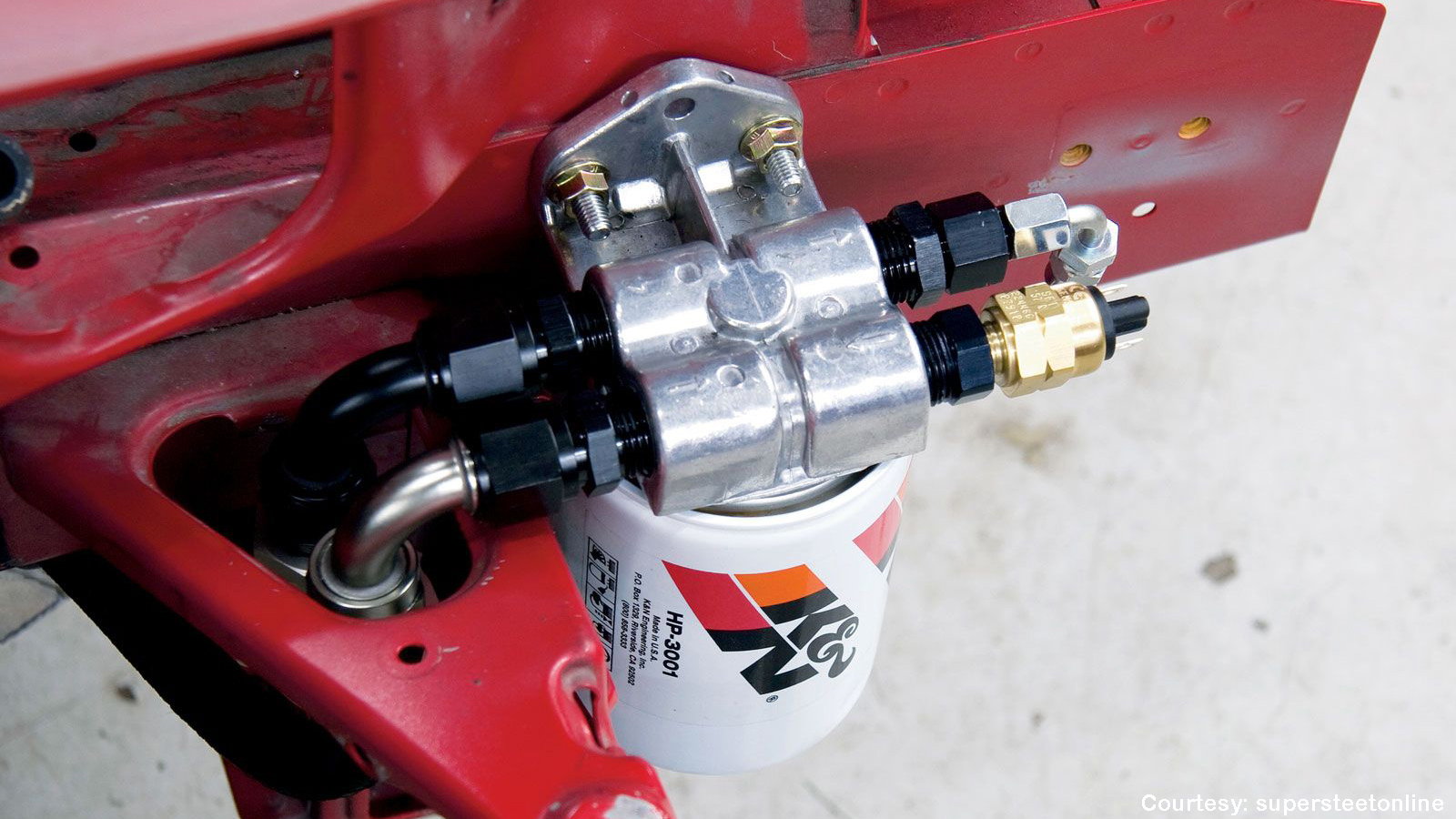Protect your Track S2000 with an Accusump System
Think coilovers and tires got you set for the track? Think again.












1. Problem
Your S2000 is a sports car straight from the factory... but it's not a race car. Put grippy tires on it and flog it around a few tight corners and you're flirting with oil starvation. The problem is that your engine was designed for street driving. It doesn't hold a ton of oil, and when you accelerate, brake, and especially corner hard, oil gets pulled away from your oil pickup and for precious moments you can lose oil pressure to critical systems (read: bearings). Repeated or extended loss of oil pressure causes heavy wear or even failure of vital engine parts. Race cars, and a few race-based exotics, have dry sump oiling systems where the oil pan is only a tray to catch oil that gets sucked up by a scavenge pump and sent to an external tank. The oil is then sent by a more usual engine oil pump back into your engine where it is circulated, before making its way down to the pan and starting its journey all over again. Your S2000, on the other hand, has a wet sump. Your pan holds all the oil and if it sloshes away from your oil pickup you're in trouble.
>>Join the conversation about the Accusump system right here in S2Ki.com.
2. Solutions
Plenty of wet-sumped cars race without lunching oil-starved bearings, but how? One way is by making it a lot harder for oil to escape from the pickup. Deeper pans that allow your oil pickup to be lowered are one option, but they don't fit every application. The most common, and effective, solution is to switch to a baffled pan. Baffled pans have barrier walls, a bit like a maze, that allow oil to run down and collect around the pickup but prevent it from quickly sloshing away. Some racing pans even have one-way doors to help keep oil where you want it. Aftermarket pans with relatively mild baffling are available for your S2000 (see above), but may not be enough to insure adequate oiling under the most demanding conditions.
>>Join the conversation about the Accusump system right here in S2Ki.com.
3. How the Accusump Works
That's where an Accusump can help. Accusumps store oil in a large, pressurized cylinder mounted outside the engine. The cylinder has a piston inside it; compressed air pushes on one side of the cylinder, and engine oil is stored on the other side. When the oil pressure inside your engine drops—like in high-g cornering situations—an imbalance is created and the pressure in the Accusump forces extra oil into the engine to maintain a safe oil pressure level. When you're on a high speed straight, or other more stable situation, the extra oil returns to the Accusump until it's needed again. Think of it as a buffer.
>>Join the conversation about the Accusump system right here in S2Ki.com.
4. Options
Accusump gives you a choice of capacity (1-3 quarts) and control valve actuation (manual or electric). With the manual version the user must open the valve before the engine starts and close it before the engine's shut off again. The electric version works the same but can be mounted in more places, though the valve it uses doesn't flow as well as the manual valve. Super Street magazine used a third type on their 2010 Project S2K car. Their Accusump EPC system had a high-flow valve that opened automatically in response to a signal from an oil pressure sending unit. The EPC system lets you set a desired psi, below which oil flows from the Accusump into your engine to save the day. When the pressure level comes back up again the valve closes the engine off but allows oil to flow back into the Accusump, recharging it.
>>Join the conversation about the Accusump system right here in S2Ki.com.
5. Cautions
When you choose the capacity of your Accusump, it's important not to go too big, especially with the EPC system. At idle your oil pressure is typically lower than the threshold your Accusump is set to, so it's going to put that extra oil into your pan. You want to make sure it's not adding so much oil that oil reaches the level of the crank, causing oil aeration. You also want to close the valve when the Accusump is fully charged with oil so that your dipstick gives a correct engine oil level reading.
>>Join the conversation about the Accusump system right here in S2Ki.com.
6. Installation and More
Super Street mounted their 1-quart Accusump in the spot above the frame rails, where their catalytic converter used to live, so you know right away it wasn't an emissions-legal set-up. They planned to re-route their exhaust, so heat wouldn't be a problem, and planned to install a flat bottom belly pan to further protect their unit. They went with Startlite oil hoses, though braided steel lines are another great option, particularly when running oil lines under the car. It's possible to mount the valve and oil pressure sending unit directly to the Accusump, but Super Street chose to mounted those remotely as well. They fabbed a mounting bracket for the valve and plumbed the sending unit into their remote oil filter. Taking the oil pressure reading from the filter was preferred, as it's closer to the engine and can sense a drop in pressure sooner than if it were mounted further downstream. To finish off the installation they placed a check valve where oil exits the filter housing, to make sure oil was directed into the block and not the pan on start-up. Click here to read more about the Project S2K car (and see how they coped with the tendency of S2000s to fill their valve covers with oil in right-hand corners).
>>Join the conversation about the Accusump system right here in S2Ki.com.
